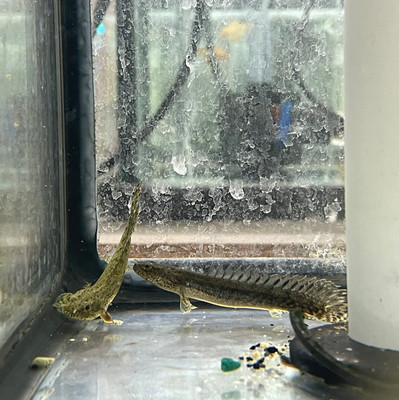Guinean Ansorgii
Posted by Max Gandara on on 14th Dec 2023
The Polypterus Ansorgii, commonly known as the Guinean Bichir or
Ansorgii, belongs to the Polypteridae family. Its genome is
characterized by a unique combination of primitive and advanced traits,
reflecting its ancient lineage. Bichirs are considered living fossils,
tracing their evolutionary roots back to the Devonian period.
Aquatic life for Guinean Ansorgii involves a mix of primitive and modern
characteristics. They are adapted to diverse environments, often
inhabiting slow-moving waters and swampy regions in their native West
African habitats. With elongated bodies and distinctive dorsal fins,
Bichirs are adept at both swimming and navigating through vegetation.
Creating a happy and healthy environment for Guinean Ansorgii involves:
- **Tank Size:** Provide a spacious aquarium with at least 75 gallons for adult Bichirs.
- **Substrate:** Use sand or smooth gravel to mimic their natural habitat.
- **Temperature:** Maintain water temperature between 75-82°F (24-28°C).
- **Filtration:** Use a powerful filter to keep water clean and well-oxygenated.
- **Hideouts:** Include caves or structures for Bichirs to seek shelter.
Companion species for Guinean Ansorgii include:
Fish:
1. **African Tigerfish (Hydrocynus vittatus):** Similar habitat requirements, coexisting well.
2. **Leopard Bush Fish (Ctenopoma acutirostre):** Compatible in size and behavior.
3. **Synodontis Catfish (Synodontis eupterus):** Bottom-dwelling companion.
4. **Endlicheri Bichir (Polypterus endlicheri):** Same genus, often kept together.
5. **Senegal Bichir (Polypterus senegalus):** Shared West African origins.
Crustaceans:
1. **Amano Shrimp (Caridina multidentata):** Peaceful and suitable for Bichir tanks.
2. **Vampire Shrimp (Atya gabonensis):** Filter feeder, non-aggressive.
3. **Red Claw Crab (Perisesarma bidens):** Territorial, but can cohabit with caution.
4. **Ghost Shrimp (Palaemonetes spp.):** Inexpensive and compatible scavengers.
5. **Cherry Shrimp (Neocaridina davidi):** Hardy and colorful addition.
Bugs:
1. **Giant Water Bug (Belostomatidae):** Aquatic insect, won't bother Bichirs.
2. **Water Scorpion (Nepidae):** Non-aggressive predator in the same habitat.
3. **Dragonfly Nymph:** (Odonata): Provides a natural hunting challenge for Bichirs.
4. **Mayfly Larva (Ephemeroptera):** Safe prey option for Bichirs.
5. **Water Beetle (Dytiscidae):** Aquatic beetle, adds diversity to the ecosystem.
Plants:
1. **Anubias:** Hardy and low-light, suitable for Bichir tanks.
2. **Java Fern (Microsorum pteropus):** Tolerant of Bichir behavior.
3. **Amazon Sword (Echinodorus spp.):** Adds greenery without being disruptive.
4. **Cryptocoryne:** Hardy and provides hiding spots.
5. **Java Moss (Taxiphyllum barbieri):** Attachable moss for a natural look.
Amphibians:
1. **African Dwarf Frog (Hymenochirus spp.):** Coexists peacefully in a shared environment.
2. **Fire-Bellied Toad (Bombina spp.):** Compatible in terms of size and habitat.
3. **African Clawed Frog (Xenopus laevis):** Aquatic, doesn't disturb Bichirs.
4. **Dart Frogs (Dendrobatidae):** Terrestrial, won't interfere with Bichirs' space.
5. **Mudskippers:** (Periophthalmus spp.): Brackish water species, unique addition.
These carefully selected companions contribute to a balanced ecosystem,
promoting the well-being of the Guinean Ansorgii and enhancing the
overall aesthetics of the aquarium.

